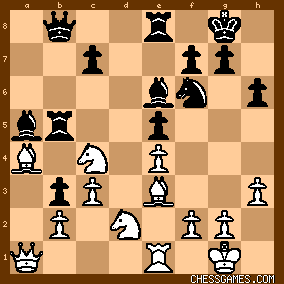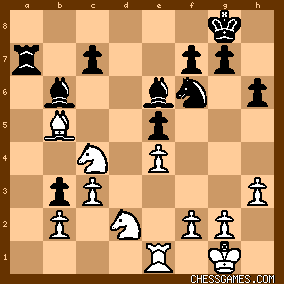| Jan-06-10 | | Bobsterman3000: Can anyone explain 35. h4 ?? |
|
| Jan-06-10 | | JuliusCaesar: To give white the option of playing g3 without dropping the pawn on h3. A great game by Kamsky - strong positional play with full tactical control. Reminded me of Karpov back in the days when he played 1. e4. |
|
| Jan-06-10 | | laskersteinitz: Gata Kamsky is a true chess professional. He needed to win this game to catch up with Almasi in the standings. |
|
| Jan-06-10 | | weisyschwarz: Kamsky made 17.Rxa5 stick, and pushed it into a strong advantage. Nicely done! |
|
| Jan-07-10 | | Albertan: I have analyzed this game in great depth using the World's strongest chess program, Deep Rybka 3, and I posted this analysis on the first page of my blog at: http://albertan1956.blogspot.com/, using the program ChessViewer Deluxe. I hope you drop by my blog and play through this game which decided first place in the 2009-2010 Reggio Emilia tournament. |
|
| Jan-07-10 | | Bdellovibrio: <Albertan> Lovely. I think of all the game analysis on this site, yours is the finest. |
|
| Jan-07-10 | | YouRang: Game notes:
Black had this position on his 23rd move [diagram]

click for larger view
He played <23...Rc8>, but better would have been 23...Bxc4! leading to 25.Nxc4 Nxe4; and if 26.Bxb5 then 26...Qxb5 27.Nxa5 Ra8 28.c4 Qb4! (not 28...Qxa5? 29.Rd8+! Rxd8 30.Qxa5  ) and the pinned knight eventually falls to ...Rxa5. ) and the pinned knight eventually falls to ...Rxa5. However, after <23...Rc8> [diagram]

click for larger view
Kamsky played <24.Ba7>, which doesn't seem as strong as the simple 24.Bxb5 leading to 24...Qxb5 25.Qxa5 Bxc4 26.Qxb5 Bxb5 27.Ra1 (threat: Ra5, and c4 if necessary, winning Pe5) 27...Ra5 and black is clearly on the defensive, trying to defend Pb3 (which is threatened by f3 & Nxb3) and Pe5 (threatened by Ra5). Luckily for Kamsky, black erred again after <24...Qxa7 25.Bxb5> [diagram]

click for larger view
Black played <25...Bb6?>. Better for black was 25...Ra8 26.Qa4 Bb6 27.Qxa7 Rxa7, and black's rook is more useful on the open a-file [diagram (variation)]

click for larger view
For example, Nxe5 can be answered by ...Ra5, while Nxb3 can be answered with ...Rb7!, setting up a discovered attack, e.g. 28.Nxb3 Rb7 29.Nbd2 Bxf2+ 30.Kxf2 Rxb5 = White is still better e.g. 28.Nxe5 Ra5 29.c4 Ne8! <threat ...Nd6> 30.Bxe8 Rxe5, and soon the pawns at b3 and c4 will fall, leaving white up a pawn, but it's unclear if it's winnable. After <25...Bb6>, Kamsky played a very strongly the rest of the way to win the game, and the ineffectiveness of black's rook is notable. By winning, he defeated the tournament leader in the last round to tie Almasi for the lead and (with tiebreaks) win the tournament in dramatic fashion. Black resigned after 31.Re8 because in view of 41...Rxc4 42.Rxe7 fxe6 43.Nxe6 Rxh4 44.Rxg7+ Kh8 45.Rxc7 leaving white up by 3 passed pawns. Trying to save the bishop another way creates a promotion threat for white, e.g. 41...Bd6 42.Nxd6 fxe6 (42...cxd6?? 43.exf7  ) 43.Ne4 and white is up a piece and a pawn ) 43.Ne4 and white is up a piece and a pawn  . . |
|
| Jan-08-10 | | kakarot: A rare case of kamsky playing an interesting game.Usually his uninspired and boring chess sweep the board.. |
|
| Jan-09-10 | | watermate: <Albertan> Great analysis on your blog!
It took me forever to find it though!
I didn't realize that the games were at the bottom. Small quibble, though. Thanks for all the effort. |
|
Jan-09-10
 | | Pawn and Two: <YouRang> In your suggested line: 23...Bxc4! 24.Nxc4 Nxe4 25.Bxb5 Qxb5 26.Nxa5 Ra8, Fritz indicates 27.c4? is an error, allowing 27...Qxa5! In your line, White could play 27.Bxh6 or 27.Qd1, with an approximately equal game. In your suggested line, after 23...Bxc4! 24.Nxc4 Nxe4, Fritz indicates White has a better continuation with 25.Rd1. After 25.Rd1, White has a small advantage: (.23) (24 ply) 25...Bxc3 26.bxc3 Qb7 27.Qb2 Rb8 28.Bxb5 Qxb5, or (.29) (24 ply) 25...f5 26.Na3 f4 27.Bxb5 fxe3 28.fxe3 Qb6 29.Qc1 c6 30.Bd3 Nc5 31.Bc4+, (.42) (20 ply) 31...Kh7 32.Rd6 Qc7 33.Qd1. Fritz agrees that Kamsky's 24.Ba7, was not nearly as strong as 24.Bxb5! Qxb5 25.Qxa5 Bxc4 26.Qxb5 Bxb5 27.Ra1. A possible continuation could be: (1.32) (23 ply) 27...Ne8 28.c4 Bc6 29.Ra6 Bb7 30.Ra3, winning the b-pawn. In your suggested line, 25...Ra8! (much better than Almasi's 25...Bb6?) 26.Qa4 Bb6 27.Qxa7 Rxa7, Fritz indicates that after 28.Nxe5 (better than 28.Nxb3?) Ra5 29.c4 Ne8 30.Bxe8 Rxe5, White has only a small advantage: (.46) (22 ply) 31.Rd1 Bxc4 32.Nxc4 Rxe8 33.Nxb6 cxb6 34.Rd4. In your suggested line, 25...Ra8! 26.Qa4 Bb6 27.Qxa7 Rxa7, Fritz indicates White's best continuation is: (.69) (21 ply) 28.Kf1 Ra2 29.Rb1 Ba5 30.Ke1 Nh5 31.Nxe5, or (.66) (21 ply) 28.Rb1 Ra2 29.Nxe5. Further analysis is needed to determine if there are any winning chances for White in either of these lines. Earlier, at move 22, Fritz preferred: (.73) (23 ply) 22.Na3 Rd5 23.exd5 Bxa4 24.Nc4 Qb5 25.Nfxe5 Qxd5. Kamsky played 22.Nfd2, which Fritz evaluated as: (.46) (23 ply) 22.Nfd2 Be6 23.Na3 Rb7 24.Bxe8 Qxe8 24.Ndc4. Kamsky's moves, 22.Nfd2 and 23.Qa1, gave Almasi the chance to reduce White's advantage to a minimal edge after 23...Bxc4! 24.Nxc4 Nxe4 25.Rd1. |
|
| Jan-11-10 | | YouRang: <Pawn and Two> Yep. You make a number of good points. And I think I crossed some lines in the first part of my analysis (in particular, 28.c4). |
|
| Jan-14-10 | | Ulhumbrus: <Pawn and Two: ...
Fritz agrees that Kamsky's 24.Ba7, was not nearly as strong as 24.Bxb5! Qxb5 25.Qxa5 Bxc4 26.Qxb5 Bxb5 27.Ra1. A possible continuation could be: (1.32) (23 ply) 27...Ne8 28.c4 Bc6 29.Ra6 Bb7 30.Ra3, winning the b-pawn...> In this variation instead of 28 c4, doesn't 28 Nxb3 win a pawn on b3 at once? White can follow the capture Nxb3 with f3 or Nc5. |
|
Jan-15-10
 | | Pawn and Two: <Ulhumbrus: ...doesn't 28.Nxb3 win a pawn on b3 at once?> You are correct, that does win the pawn immediately. However, Fritz preferred a different continuation, delaying the capture of the pawn. I had provided only that line, indicating it was one possible continuation. Here is some additional analysis by Fritz: after 24.Bxb5 Qxb5 25.Qxa5 Bxc4 26.Qxb5 Bxb5 27.Ra1 Ne8: (1.32) (26 ply) 28.c4 Bc6 29.Ra6 Bb7 30.Ra3 Nd6 31.f3 Bc6, (1.37) (23 ply) 32.Kf2 f6 33.Bc5 Nb7 34.Nxb3, or (1.32) (23 ply) 32.Rxb3 Ra8. In the 28.Nxb3 continuation: (1.17) (26 ply) 28.Nxb3 Nd6 29.Ra5 f6 30.Bc5 Bd7 31.bxd6 cxd6 32.Nd2 Kf7 33.f3 Ke6 34.Kf2 g6 35. Ke3 f5, (1.23) (22 ply) 36.Kd3 fxe4+ 37.fxe4 Rf8. Fritz continues to slightly prefer 28.c4 over 28.Nxb3. However, either continuation seems good. |
|
|
|
|





